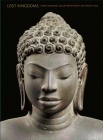History on Display: Lost Kingdoms

In the first millennium, a series of kingdoms that most of us have never heard of grew up in Southeast Asia : Pyu, Funan, Zhenla, Champa, Dvaravati, Kedah, and Srivijaya. Their boundaries roughly reflect the political map of the region today. Over time, their rulers adopted Hinduism and/or Buddhism as their official religions. In 1968, George Coedès described this official adoption of the religions of the Indian subcontinent in his seminal work The Indianized States of South East Asia. He argued that Indian states colonized Southeast Asia. More recent scholarship suggested that the process of Indianization was less thorough than Coedès believed* and that it was a result of acculturation rather than colonization. The exhibit was billed as using “sculpture as a lens to explore this period of Southeast Asian history.” I had read Coedès as an undergraduate and had followed the developing academic argument in a low-key way over the years. I was jazzed about the exhibit, to say the least.
Lost Kingdoms was both artistically breath-taking and historically disappointing. The artifacts on display, many of them loaned by the governments of Cambodia, Vietnam, Thailand, Malaysia, Singapore, and Myanmar and never before seen outside their countries, are fabulous and beautifully displayed. But as is so often the case in art museums, the curators focused on describing the exhibits as objects without providing much context. I wanted more information on long-distance trade routes within the Indian Ocean World, Buddhist merchants, and the use of Vishnu as the model of kingship. I wanted to asked my fellow viewers whether they knew enough about Buddhism, Vishnu, Shiva, Durga, rakshas,** and nagas for the signs to mean anything. The conversations I overheard suggested that most of them were concentrating on whether a particular piece came from Vietnam or Cambodia.
In all fairness, I did not rent an audio tour–possibly it was full of historical goodies. More importantly, the accompanying catalog, written by John Guy, is beautiful, well-written and thoughtful.***
My recommendation? If you’re in New York, take the time to see the exhibit but moderate your historical expectations. If you’re actively interested in the “lost kingdoms” of early Southeast Asia, track down the book.
*First guy in the field gets a pass for being overly enthusiastic.
**No, not rickshaws, Autocorrect. Though my guess is that most everyone in the hushed gallery, including me, knew more about rickshaws than anything they were looking at.
***I almost gave in to the temptation to buy it. After all, I’d promised not to go the The Strand, not to return home bookless. I resisted, but once I’m in the new office with the additional bookshelves…..